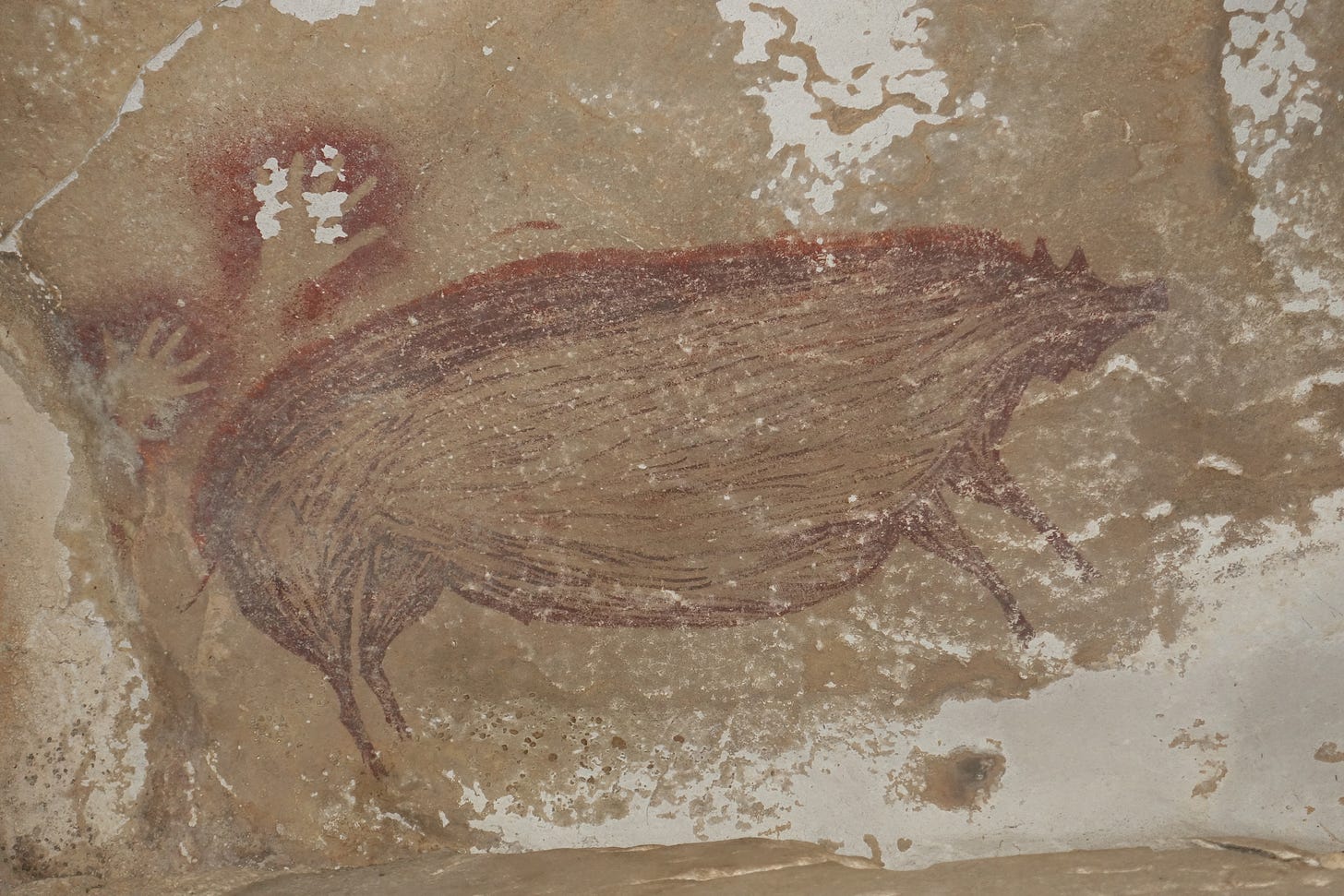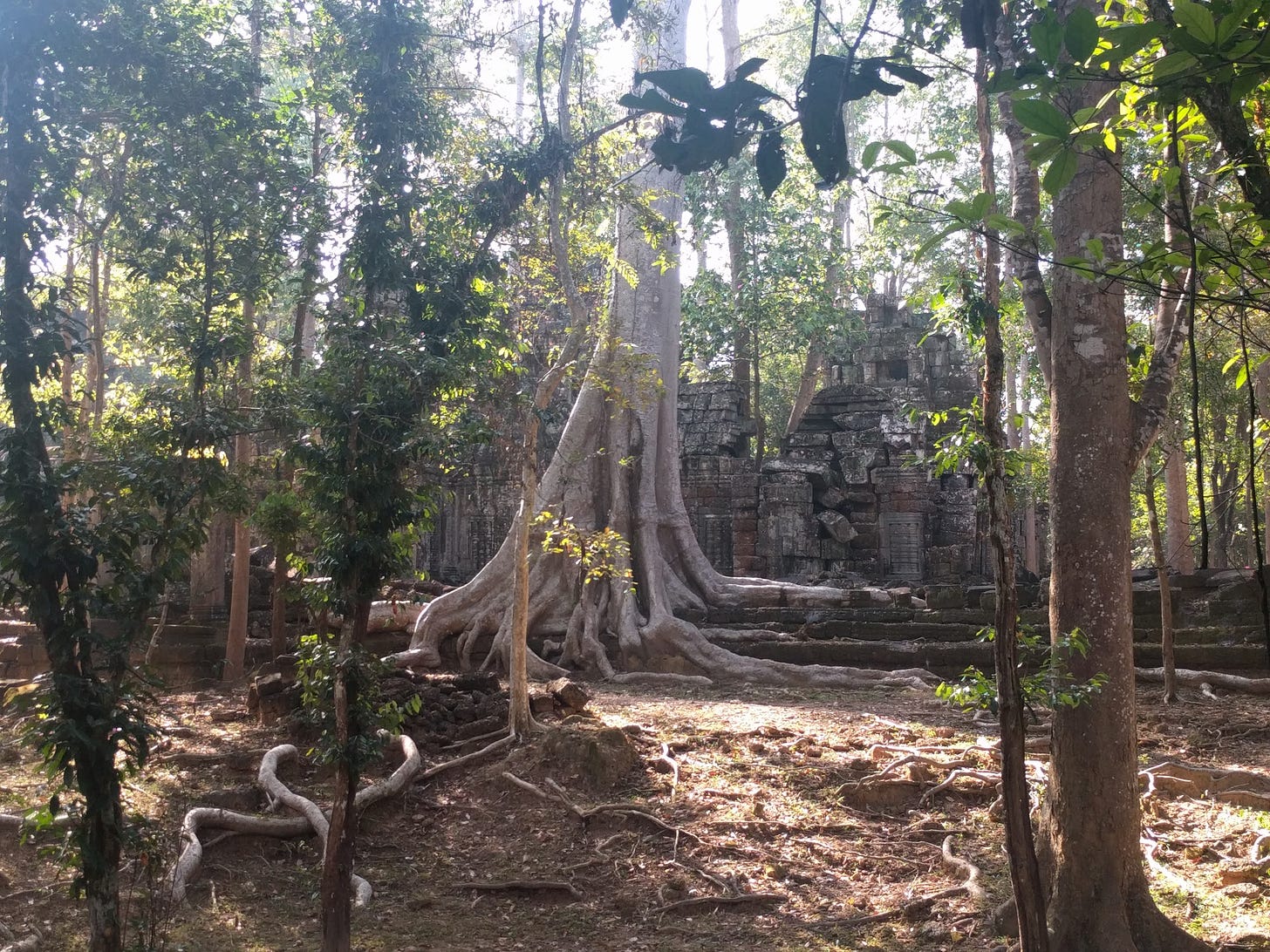Let's put that 45,000 year-old pig into context
Civilization as we know it emerged from the tropics in the global south
This picture of a warty pig is giving me life. It’s from a cave in Sulawesi, Indonesia, where people drew it roughly 45,000 years ago, along with several other pigs and some handprints. It’s not the first time archaeologists have found extraordinarily ancient cave art in Indonesia either.
In 2017, the same researchers found a complicated painting in another Indonesian cave. Dated at 44,000 years old, the painting showed more warty pigs — apparently a favorite among the peoples of these islands — as well as hunting scenes. Best of all, the tableau included therianthropes, or fantastical human-animal hybrid creatures, which hint at complex mythological backstory to the pictures. One is a human with a bird head or muzzle, another has a tail, and still others appear to be part-reptile.
These images are tens of thousands of years older than the famous drawings at Lascaux in France, which are dated to about 17,000 years ago. So the warty pig is simply the latest piece of evidence that cultures with complex symbolism were developing in the tropics long before they did in Europe. Another piece of evidence comes from proto-farms, which have been discovered dating back 45,000 years in the equatorial regions of Africa, the Americas, and southeast Asia. These proto-farms, which involved clearing land with fire, draining swamps, and planting trees, were the seeds of a distinctly tropical urban culture that developed in these regions.
Tens of thousands of years later, vast, sprawling garden cities emerge in southeast Asia and elsewhere on the equator. Unlike the massive stone monuments and brick houses that characterize ancient cities in the Mediterranean, these tropical cities favor homes made of wood and other perishable materials, as well as urban farms interspersed between high-density neighborhoods. Angkor, capitol of the powerful Khmer Empire, is one of those cities.
For years, Western archaeologists didn’t understand how people in southeast Asia could have built such a magnificent city in the middle of thick jungle that’s frequently lashed by monsoons. But new discoveries like the warty pig painting, and those proto-farms, make it clear that the global south developed its own urban traditions and technologies that suited the environment. And these days, with climate change transforming urban life, we might want to look to these tropical urban traditions for inspiration. This is a major topic in my book, Four Lost Cities, which comes out in just 10 days! In it, I explore two ancient garden cities, Angkor and Cahokia, and describe how their people dealt with urban planning and agriculture.
Women from the past and future
I started the new year by writing a piece for the New York Times about how women have always played a key role in politics, war, and hunting — new archaeological evidence shows that women have been honored as warriors and hunters for more than 9,000 years. So there’s nothing “natural” about women being forced into nurturing roles, while men are pushed into aggressive ones. It’s culture all the way down.

This week Tor.com published one of my favorite short stories I’ve ever written. “#Selfcare” is set in near-future San Francisco, where Edwina is desperate to keep her crappy job at a skincare clinic because the alternative is endless degrading gig work. But then her boss angers the fae on social media, and things start to get truly weird. It’s a story about worker solidarity and hot fae tricksters. It’s free online, and I promise it will make you smile.
Other things to read about!
I loved Maddie Stone’s recent newsletter about whether humans really can reduce climate change. Maddie is a former environmental scientist so her insights are incredibly valuable.
Andrew Liptak is killing it with his series on right wing extremism and science fiction. His piece about how right wingers have appropriated the term “Orwellian” is on point.
And I was glad to see Noah Smith popularizing the phrase “cold civil war” to describe this moment in history. It’s very apt, and I’ve started using it a lot.
My next book is Four Lost Cities: A Secret History of the Urban Age. It's coming out in February 2021, and you can pre-order it now. You can find information and ordering links for my other books on my website, helpfully organized into science fiction and journalism. You can also follow me on Twitter or Instagram — or listen to Our Opinions Are Correct, the fortnightly podcast I co-host with Charlie Jane Anders. If someone forwarded this email to you, you can subscribe to it here.



